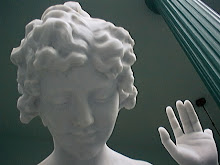
Truman Capote went to visit Brando in Kyoto in 1957 while he was filming Sayonara. He describes the Japanese-style hotel room:
"All that he owned seemed to be out in the open. Shirts, ready for the laundry; socks, too; shoes and sweaters and jackets and hats and ties, flung around like the costume of a dismantled scarecrow. And cameras, a typewriter, a tape recorder, an electric heater that performed with stifling competence. Here, there, pieces of partly nibbled fruit; a box of the famous Japanese strawberries, each berry the size of an egg. And books, a deep-thought cascade, among which one saw Colin Wilson's "The Outsider" and various works on Buddhist prayer, Zen meditation, Yogi breathing, and Hindu mysticism, but no fiction, for Brando reads none. He has never, he professes, opened a novel since April 3, 1924, the day he was born, in Omaha, Nebraska."An externalization of all of Brando's interests, aspirations, and failures, this description does more justice to him than any statement that he makes in his monologue about himself under the scrutiny of the tiny, malevolent writer. Capote's piece is like the mirror-image of a recent New Yorker piece by Claudia Pierpont. Capote documents Brando's contradictions, self-involvement, and childlike behavior, casting the actor as shallow, troubled, fragmented, arrogant, and alone. Pierpont turns that around and with the same information, creates a portrait of someone deep, troubled, fragmented, humble, and lonely. She is forgiving and compassionate, while recognizing all of the same issues. Brando in 1957 was already a popular obsession, universal icon, and cultural cliche. Where Capote tries to expose the man behind the curtain, Pierpont brings out the sadness and misery of a person in that position, with a talent that cannot be realized, not only because of the fame and expectations, but also because of emotional imbalance.
Pierpont also gives serious attention to Brando's talent, technique, and hit-0r-miss history. Describing Brando's performance in Streetcar, she conveys the artistry he brought to modulating his performance in order to make the transition from stage to screen. Viewed today, the hashed-over Kowalski tee-shirt rending Streetcar trope is banished by his physical beauty and his rendering of the childlike ignorance and menace that flicker through the movie like a living current of electricity. And yet, Capote quotes Brando himself as saying about the movie, released six years earlier in 1951, "Of course, movies date so quickly. I saw 'Streetcar’ the other day and it was already an old-fashioned picture."
Such a beautiful failure...
Claudia Pierpont Roth, New Yorker, 10/27/2008: Method Man
Truman Capote, New Yorker, 1957: The Duke in His Domain
Street Named Desire in IMDB

No comments:
Post a Comment